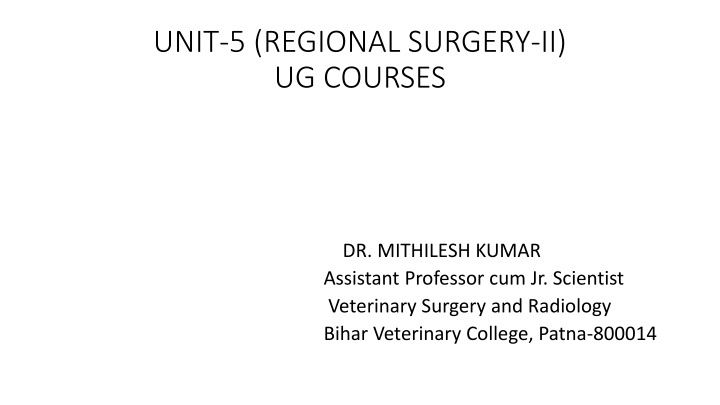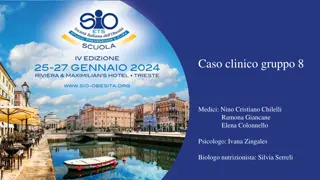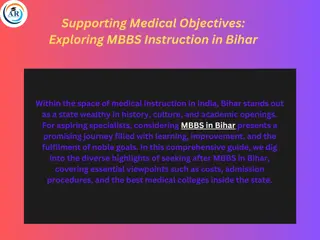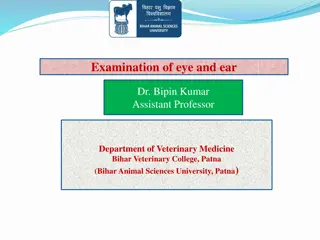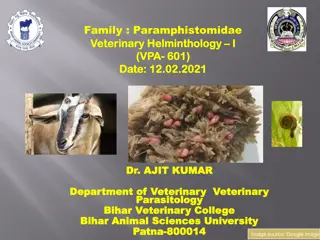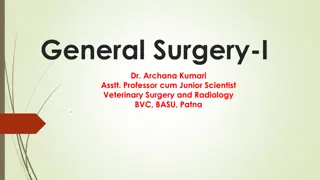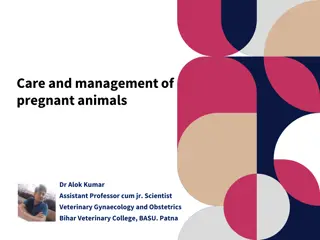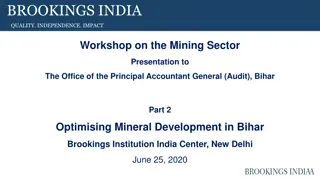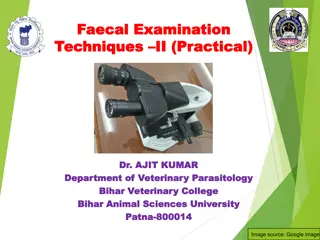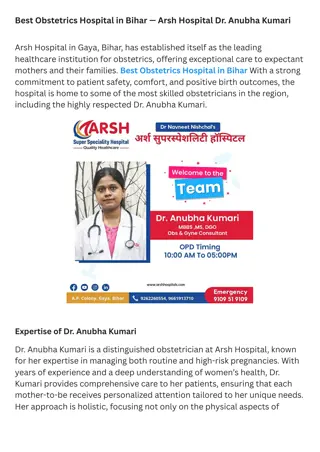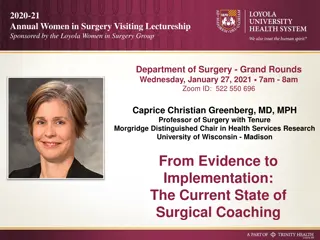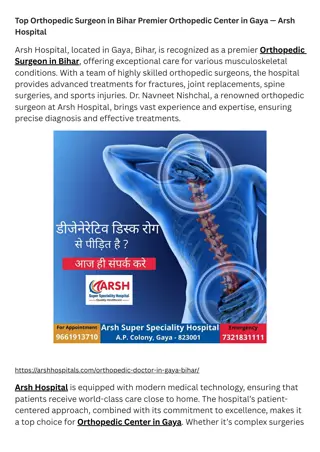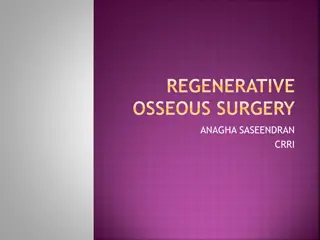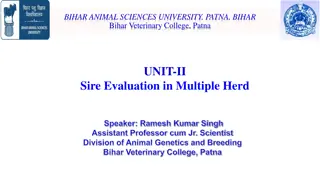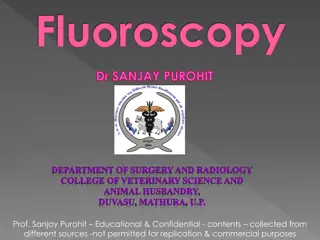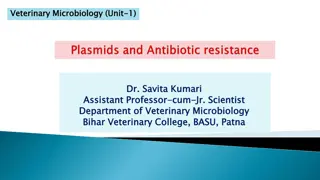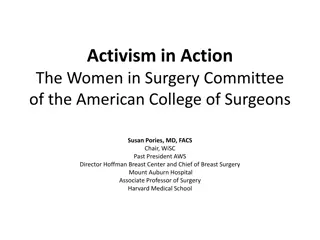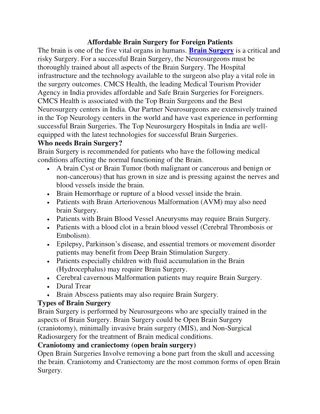Regional Surgery-II in Veterinary Science at Bihar Veterinary College
Assistant Professor cum Jr. Scientist Dr. Mithilesh Kumar specializes in Veterinary Surgery and Radiology at Bihar Veterinary College, Patna. The course "UNIT-5 (REGIONAL SURGERY-II)" is a part of the undergraduate curriculum. This course provides in-depth knowledge and practical skills in the field of regional surgery, focusing on specific anatomical regions relevant to veterinary practice. Students will learn advanced surgical techniques, diagnostic imaging, and treatment options for various surgical conditions in animals. Dr. Mithilesh Kumar brings his expertise to guide and mentor students, preparing them for successful careers in veterinary surgery.
Download Presentation

Please find below an Image/Link to download the presentation.
The content on the website is provided AS IS for your information and personal use only. It may not be sold, licensed, or shared on other websites without obtaining consent from the author.If you encounter any issues during the download, it is possible that the publisher has removed the file from their server.
You are allowed to download the files provided on this website for personal or commercial use, subject to the condition that they are used lawfully. All files are the property of their respective owners.
The content on the website is provided AS IS for your information and personal use only. It may not be sold, licensed, or shared on other websites without obtaining consent from the author.
E N D
Presentation Transcript
UNIT-5 (REGIONAL SURGERY-II) UG COURSES DR. MITHILESH KUMAR Assistant Professor cum Jr. Scientist Veterinary Surgery and Radiology Bihar Veterinary College, Patna-800014
THORACOTOMY Means opening of thoracic cavity. Techniques are (i) Intercostal incision (ii) Rib resection (iii) Split rib incision Thoracotomy through paracostal abdominal incision is mainly indicated to repair rents in diaphragm or to drain diaphragmatic abscess.
Pre-operative evaluation of the lesion by percussion, auscultation and radiography and ultrasonography of the chest can help to outline the exact location of the lesion. Intercostal Incision:- Intercostal incision should be placed cranial to rib as intercostal vessels are located caudally. The incision should be extended with scissors to the desired length. A self retraining rib retractor is used for adequate exposure of the intrathoracic organs. A series of interrupted sutures are placed around the adjacent ribs using nonabsorbable suture material for closure of the wound.
A simple continuous suture in the intercostal muscles seals the incision against air leaks. The overlying muscles and skin are in routine manner. Rib resection:- After skin and muscles have been incised a longitudinal incision is made on the periosteum of the exposed rib. The periosteum is stripped from the lateral surface and cranial and caudal borders of the rib with help of periosteal elevator. A curved haemostat introduced between the periosteum and medial surface of the rib is moved up and down to separate the periosteum completely from the rib. To expose the periosteal bed, the rib is resected with wire saw at the proximal end.
The distal end is then disarticulated at the costochondral junction. The pleural incision is extended dorsally and ventrally with scissors. The wound is closed in layers i.e. the pleura and periosteum together, intercostal muscles and then superficial muscles and fascia together. Continuous lock stich sutures using heavy chromic catgut. The skin sutured routinely. Split rib technique :- After exposing the rib, straight longitudinal incision is made in its center by means of an oscillating electrical bone saw. The rib is then sectioned transversely at either ends of the primary incision.
Closure of rib incision is accomplished by placing 4 to 5 interrupted sutures of either stainless steel wire or heavy black braided silk around the rib. Muscles closed in layers and skin sutured as usual. It provides maximum exposure of the pleural space without involvement of rib retractors. Closure is simple and quick.
SURGICAL APPROACH OF THORACIC CAVITY IN BOVINE Thoracocentesis 5thto 7thintercostal space Drainage of pericardial sac 5thIntercostal space or 5thrib Pericardiectomy/ Pericardiotomy 5thrib Diaphragmatic herniorrhaphy 6thor 7thrib Diaphragmatic abscess 7thrib Pneumonectomy 5thrib
THORACOCENTESIS:- indicated to collect the fluid for physical, cytological, biochemical and culture and sensitivity tests. These tests help to point the cause of the effusions. All aseptic precautions should be used for thoracocentesis to avoid introduction of infection. Pneumothorax:- Air accumulates in the pleural space. THORACIC WOUNDS: Wound occur as a result of trauma. It is necessary to prevent pneumothorax and collapse of lung. Rib fractures due to blow to the thoracic wall cause splinters or sharp rib ends which may penetrate the lungs to cause pneumothorax. Non penetrating wounds are common.
TRAUMATIC PERICARDITIS It is occurs as a result of penetration of the pericardium by sharp foreign body. Distance between reticulum and pericardium is only few cm. Sharp foreign body can easily pierce the diaphragm and enter the pericardium. Exudative, suppurative or constrictive pericarditis characterized by symptoms of toxemia or congestive heart failure. Higher incidence in pregnant or recently calved animals as increased intraabdominal pressure pushes the foreign body towards thorax.
Pericardium may be pierced. Sometime pierce the myocardium and come through thoracic wall. Abscess forms on either side of chest behind the elbow. In few cases come into reticulum and rarely come in faeces. Trauma to pericardium initiates inflammation and exudates continue to accumulate in the pericardial sac. Contamination spreads. Formation of adhesions between epicardium and pericardium. Fluid accumulates in the Pericardial sac impairs pump of heart. Exhibits signs of congestive heart failure.
Right sided heart failure is common. Absorption bacterial toxins. CLINICAL SIGNS:- Complete anorexia, drop in milk yield and reluctance to walk, walk with short steps and stiff gait, Pyrexia, increased pulse rate, abdominal respiration, arched back, abducted elbows, grunting, brisket oedema. Oedema of jaw, dewlap and ventral abdominal region extending upto udder indicating in advance cases, indicating congestive heart failure. The jugular veins engorged and show pulsation. Initially pericardial friction sounds are heard on auscultation. Later muffled heart sound in more fluid content
Splashing heart sound if gas. Prognosis is poor with signs of congestive failure. DIAGNOSIS:- Clinical signs, Pericardiocentesis and radiography. Hematological, biochemical and electrocardiographic changes indicate severity . Pericardiocentesis through 5thor 6thintercostal space shows offensive odour fluid. low erythrocyte count, Hb and packed cell volume alongwith leukocytosis, neutrophilia and elevated ESR Urine is acidic albuminuria.
Jugular veins distended and pulsatile. Lateral radiography of chest to diagnose the foreign body and shadow of heart. Radiography of chest helps to differentiate pericarditis from DH. Pericardiocentesis. TREATMENT :- Conservative treatment- diuretics, antimicrobial therapy. Elevation of front feet by 15-20cm. Surgical treatment:- Pericardiocentesis, Pericardiotomy or Pericardiectomy with or without pericardial graft.
Pericardiocentesis drain the fluid from the pericardial sac and inject antibiotics and proteolytic enzymes. Pericardiocentesis done in standing animal. Large bore needle is inserted between 4thand 5thintercostal space at the level of elbow region. Pericardiotomy Laparoruminotomy done before pericardiotomy. Foreign body penetrating diaphragm or pericardium should be removed. Pericardiotomy involves incising the pericardium and draining the fluid.
The main objectives of pericardiocentesis are to drain fluid from pericardial sac and inject antibiotics and proteolytic enzymes. It is temporary relief. Pericardiocentesis done in standing animal with forelimb drawn forward. Needle inserted between 4thand 6thintercostal space in left side. Laparorumenotomy done before pericardiotomy to remove the FB,s. Select the early cases. Surgery should be done early diagnosis and has not lost compete appetite, good body condition and young. Thoracic approach mentioned earlier.
5% DNS given intravenously during surgery. Following thoracotomy, pericardiotomy or pericardiectomy done. Pericardiotomy involves incising the pericardium and draining the fluid. Many effusions are bread and butter type remove the exudate to clear the pericardium. Foreign body removed. Wash the cavity with warm isotonic saline solution containing antibiotics. Pericardial and pleural incision closed with continuous suture suture using absorbable suture material.
Penicillin is sprinkled inside cavity. Close the thoracic cavity as usual. Sometime drainage tube attached inside the pericardial sac. Flushing with mild antibiotic solution containing proteolytic enzyme daily for several days until no discharge from the sac.
Occurs in high producing adult dairy cows in age group of 3-7 years. Reported in bulls, calves and sheep. RDA is relatively more frequent than LDA. Rare in buffaloes. In DH part of abomasum gets herniated along with reticulum. Exhibit signs of DH without signs of abomasal involvement. Correction of DH cures the condition. Detected only by laparoruminotomy. Occur at any time of gestation
ABOMASAL DISPLACEMENT The abomasum is wandering organ due loose attachment with greater and lesser omentum. Easily displace to left (left displacement of abomasum or LDA) Displace right (Right displacement of abomasum or RDA) Rotation on its mesenteric axis results in an abomasal torsion or abomasal volvulus. Countries where feed consists of high proportion of grains and concentrates than roughage.
High incidence three weeks antepartum to four weeks postpartum. The LDA occurs more frequently antepartum while RDA and AV higher postpartum. Aetiology:- Spontaneous recovery from LDA leading to RDA. RDA is more serious problem as some degree of volvulus exists. Few cases volvulus of the reticulum and abomasum associated. No exact etiology. Abomasal atony with increased gas production may act as a predisposing causes.
Feeding of high concentrate ration increases production VFA. Unabsorbed VFA pass from rumen into abomasum and decrease the contractility. Results accumulation of ingesta in the abomasum with production of large volumes of gases causing distention and displacement of the organ. A linear relationship has been reported between the amounts of grains fed and amount of gases produced. Hypocalcemia, metritis, mastitis, ketonuria, traumatic reticulitis may decrease the motility of abomasum predispose to displacement.
Metabolic alkalosis also reduces abomasal contractions. During pregnancy rumen is lifted by gravid uterus. Abomasum may slide to the left under the rumen. Following parturition rumen will come to its normal position. Distended and atonic abomasum get trapped between the rumen and Left abdominal wall to cause LDA. Clinical signs:- LDA Intermittent anorexia, gradual decrease in milk yield and ketosis, rapid loss of body condition, dull, listless, shifting of weight from one leg to other due to abdominal pain, Scanty faeces diarrhoeic constipated.
Sluggish and weak rumen movement, T, HR, RR are normal, dehydration. High pitched tympanic resonance (ping) heard oval area along a line from the left elbow to tuber coxae. Bulging of left paralumbar fossa. LDA rarely palpated per rectal examination. Simple dilatation of abomasum and RDA are similar to LDA. The distended abomasum may be palpated caudal to last rib. Tympanic resonance heard cranial to right para lumber fossa. In AV signs are more pronounced.
These signs include abrupt drop in milk yield, complete anorexia, acute abdominal pain and scanty faeces. Diagnosis:- History, clinical signs, detection of tympanic resonance. Rapid heart rate and drop in milk yield help to differentiate AV from RDA. Liptek test:- A 18 gauge needle is inserted aseptically just below the area of resonant ping in the left (LDA) or right (RDA) abdominal wall fluid is aspirated. If pH of fluid is between 1-4 indicates an abomasum. If pH 5-7 indicate rumen fluid.
TREATMENT: Correction of the displaced abomasum, restoration of GI motility, rehydration and correction of metabolic disorders. Calcium borogluconate, neostigmine, saline cathartics etc. Administration of warm saline solution and mineral oils evacuate GI content. Roll the animal side by side place in dorsal recumbency. Fixation of abomasum and omentum to body wall.
Left flank omentopexy (Utrecht method) Abdomen entered through 20cm long vertical incision in left flank. Abomasum lies under the incision. Greater omentum located needle threaded with 2 metre passed in or out of omentum with mattress suture over 7 cm. Suture material should extend from each end of suture. Abomasum is decompressed using a 13-14 gauge needle attached to rubber tube. Abomasum is pushed to the normal position.
Both end of suture carried along the internal body wall and forced through the ventral midline to midline. Assistant grasp the two ends suture pulled and and tied outside the body wall. After 4 weeks suture removed close to skin. LEFT AND RIGHT FLANK ABOMASOPEXY:- Similar to left flank omentopexy Suture is placed in simple continuous or interlocking in musculature of the greater curvature of abomasum. The ends are brought through ventral abdominal like omentopexy Left flank-LDA and right flank-RDA.
Right flank omentopexy:- Right flank laparotomy is done in the standing animal. Abomasum is decompressed and volvulus corrected and abomasum repositioned. Two mattress suture of heavy catgut, one each cranial and caudal to incision are placed through peritoneum, transverse abdominal muscles and fold of omentum. The peritoneum and transverse muscles are then sutured in simple continuous pattern incorporating omentum. The laparotomy incision is closed in usual manner.
The aim is to produce adhesions between parietal and visceral peritoneum covering the greater omentum to hold omasum in normal position. Ventral paramedian abomasopexy:- The technique is used in both LDA and RDA. Surgery done under dorsal recumbency by sedation. The abdominal cavity entered through long incision between the ventral midline and right subcutaneous abdominal vein starting from just caudal to xiphoid process and cranial to umbilicus. The abomasum is pulled towards incision, decompressed and repositioned.
The greater curvature is sutured to the peritoneum and muscles of lateral aspect of the paramedian incision. The abdomen incision is closed routinely. This technique is easy.
CAECAL DILATION AND TORSION It involves distension, displacement and torsion of caecum. Free end of caecum in cattle is devoid of mesentery lead to rotation. Dilatation may proceed to torsion. After parturition and pregnant animal of cow, bullocks, sheep and goats may observed. Also observed in buffalo. Etiology not known But excessive grain feeding is animal reported. Feeding of excessive grain increased VFA and gas - Atony or hypomotility of caecum - dilation and torsion of the organ
CLINICAL SIGNS :- Simple dilatation of caecum may be acute if torsion occurs. Symtom similar to bowel obstruction. Early cases abdominal pain. Rapid loss of appetite, cessation of defaecation and dehydration. T, PR and HR are normal in simple dilatation but subnormal Temp and tachycardia in case torsion. Hypomotility of rumen or atony of rumen present in most of the cases. The right paralumbar fossa may be distended and tympanic resonance may be heard.
Similar resonance is heard in case of RDA but resonant area is smaller and more caudal in caecal dilation. The distended caecum may be rectally palpable like long cylindrical movable gas filled structure. Rupture of caecum may cause death. DIAGNOSIS:- History, clinical signs, auscultation and percussion and rectal palpation. Right flank laparotomy. Hypochloraemic, hypokalemic metabolic alkalosis. Hemoconcentration, azotaemia observed.
Similar finding are also observed in bowel obstruction. TREATMENT:- Conservative treatment in case of dilatation without torsion. It is parasympathomimetic drugs such as neostigmine. It can given S/C every 3 to 4 hrs over 2 to 3 days in gradually decrease dose 12.5 mg to 2.5 mg Alternative continuous drip of drug (200 mg in 10 litres of normal saline. Liquid paraffin oral purgative.
Above fails surgery indicated. Right flank laparotomy is done standing animal and free end of caecum is exteriorized. Packing the laparotomy wound and caecotomy done to remove the content. Caecum is closed after cleaning with NS. Suturing done with absorbable suture material like enterotomy. Torsion is corrected and caecum paled in normal position. The laparotomy wound is closed in the usual manner. Typhlectomy is also indicated in necrosed caecum. Blood vessels ligated and resected necrosed caecum
